View in other NatureServe Network Field Guides
NatureServe
Montana
Utah
Wyoming
Idaho
Wisconsin
British Columbia
South Carolina
Yukon
California
New York
Dotted Smartweed - Polygonum punctatum
Other Names:
Persicaria punctata
Native Species
Global Rank:
G5
State Rank:
S3S4
(see State Rank Reason below)
C-value:
4
Agency Status
USFWS:
USFS:
BLM:
External Links
State Rank Reason (see State Rank above)
Polygonum punctatum is known from about five counties. This species may be easily mis-identified or undercollected. More data on population sizes and distributions is needed before warranting it as a Species of Concern.
- Details on Status Ranking and Review
Population Size
ScoreU - Unknown
Range Extent
ScoreF - 20,000-200,000 sq km (~8,000-80,000 sq mi)
Area of Occupancy
ScoreD - 6-25 4-km2 grid cells
Number of Populations
ScoreB - 6 - 20
Number of Occurrences or Percent Area with Good Viability / Ecological Integrity
ScoreB - Very few (1-3) occurrences with excellent or good viability or ecological integrity
Environmental Specificity
ScoreD - Broad. Generalist or community with all key requirements common
Long-term Trend
ScoreU - Unknown
Trends
ScoreU - Unknown
Threats
ScoreU - Unknown
CommentThreats: Unknown/undetermined.
Intrinsic Vulnerability
ScoreC - Not intrinsically vulnerable
General Description
Plants: Rhizomatous-stoloniferous perennials (McGregor et al. 1986), glandular-punctate. Stems upright to prostrate or decumbent and rooting at the nodes, somewhat branched, up to 1 meter in length (Hitchcock et al. 1964).
Leaves: Short-petiolate; the blades with or without a central dark blotch, lanceolate to oblanceolate (Lesica 2012), (3)5-10(12) cm in length (Hitchcock et al. 1964), up to 2 cm in width, acuminate (McGregor et al. 1986), glandular-punctate and ciliate, otherwise usually smooth (Hitchcock et al. 1964); stipules (ocreae) brown and papery (Lesica 2012), enveloping the stem obliquely, 10-15 mm in length, typically with a few appressed hairs and several marginal bristles (Hitchcock et al. 1964).
Inflorescence: Flowers in erect or arching (McGregor et al. 1986), narrow, terminal and typically 2 to a few lateral racemes; racemes up to 10 cm in length (Hitchcock et al. 1964); flower clusters interrupted, particularly below, not crowded, the groups of flowers subtended by sheathing bracts (ocreolae) (McGregor et al. 1986); pedicels 1–4 mm in length, ascending (Lesica 2012).
(Lesica’s contribution adapted from
Lesica et al. 2012. Manual of Montana Vascular Plants. BRIT Press. Fort Worth, TX)
Phenology
Flowers July-October (McGregor et al. 1964).
Diagnostic Characteristics
Dotted Smartweed is distinguished almost entirely on its darker, shinier seeds from the similar Marshpepper Smartweed (Polygonum hydropiper), which has dull brown seeds. As other species are recognized to have dimorphic seeds, the natural separation of these two species is questionable (Hitchcock et al. 1964). Douglas et al. (1999) adds that, unlike Dotted Smartweed with its usually 5-lobed perianths and interrupted racemes, Marshpepper Smartweed has mostly 4-lobed perianths, and racemes that are barely interrupted.
Species Range
Montana Range
Range Descriptions
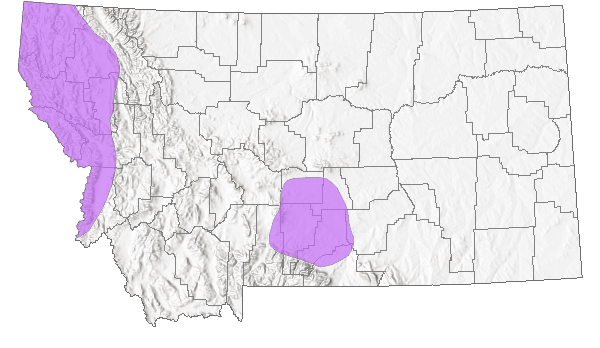
 Native
Native
Range Comments
Throughout temperate and tropical North America, S. America (Lesica et al. 2012. Manual of Montana Vascular Plants. BRIT Press. Fort Worth, TX).
Observations in Montana Natural Heritage Program Database
Number of Observations: 15
(Click on the following maps and charts to see full sized version)
Map Help and Descriptions
Relative Density
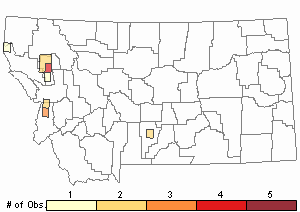
Recency
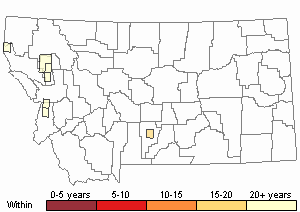
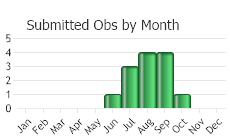
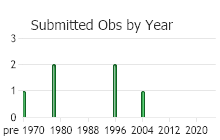
 (Observations spanning multiple months or years are excluded from time charts)
(Observations spanning multiple months or years are excluded from time charts)
Habitat
Ecology
POLLINATORS The following animal species have been reported as pollinators of this plant species or its genus where their geographic ranges overlap:
Bombus bifarius,
Bombus flavifrons,
Bombus frigidus,
Bombus melanopygus,
Bombus sylvicola,
Bombus occidentalis,
Bombus pensylvanicus,
Bombus insularis, and
Bombus kirbiellus (Macior 1974, Colla and Dumesh 2010).
Reproductive Characteristics
Flowers: Flowers typically extended beyond the involucres; perianth 3-3.5 mm in length, the tepals unequal, ovate to oblong, densely glandular-punctate, joined for nearly half their length, greenish with white or pink margins; stamens 8, styles 2-3, free or attached together basally, shy of 0.5 mm in length (Hitchcock et al. 1964).
Fruit: Achene lenticular or 3-sided (Hitchcock et al. 1964), not winged, 2–3 mm long, shiny dark brown to black (Lesica 2012).
(Lesica’s contribution adapted from
Lesica et al. 2012. Manual of Montana Vascular Plants. BRIT Press. Fort Worth, TX)
Stewardship Responsibility
References
- Literature Cited AboveLegend:
 View Online Publication
View Online Publication Colla, S.R. and S. Dumesh. 2010. The bumble bees of southern Ontario: notes on natural history and distribution. Journal of the Entomological Society of Ontario 141:39-68.
Colla, S.R. and S. Dumesh. 2010. The bumble bees of southern Ontario: notes on natural history and distribution. Journal of the Entomological Society of Ontario 141:39-68. Hitchcock, C. L., A. Cronquist, M. Ownbey, and J. W. Thompson. 1964. Vascular Plants of the Pacific Northwest. Part 2: Salicaceae to Saxifragaceae. University of Washington Press, Seattle. 597 pp.
Hitchcock, C. L., A. Cronquist, M. Ownbey, and J. W. Thompson. 1964. Vascular Plants of the Pacific Northwest. Part 2: Salicaceae to Saxifragaceae. University of Washington Press, Seattle. 597 pp. Lesica, P., M.T. Lavin, and P.F. Stickney. 2012. Manual of Montana Vascular Plants. Fort Worth, TX: BRIT Press. viii + 771 p.
Lesica, P., M.T. Lavin, and P.F. Stickney. 2012. Manual of Montana Vascular Plants. Fort Worth, TX: BRIT Press. viii + 771 p. Macior, L.M. 1974. Pollination ecology of the Front Range of the Colorado Rocky Mountains. Melanderia 15: 1-59.
Macior, L.M. 1974. Pollination ecology of the Front Range of the Colorado Rocky Mountains. Melanderia 15: 1-59. McGregor, R.L. (coordinator), T.M. Barkley, R.E. Brooks, and E.K. Schofield (eds). 1986. Flora of the Great Plains: Great Plains Flora Association. Lawrence, KS: Univ. Press Kansas. 1392 pp.
McGregor, R.L. (coordinator), T.M. Barkley, R.E. Brooks, and E.K. Schofield (eds). 1986. Flora of the Great Plains: Great Plains Flora Association. Lawrence, KS: Univ. Press Kansas. 1392 pp.
- Additional ReferencesLegend:
 View Online Publication
View Online Publication
Do you know of a citation we're missing? Britton, N. L. and A. B. Brown. 1913. An Illustrated Flora of the Northern United States, Canada, and the British Possessions. 2nd Edition in 3 Volumes. New York, NY: Charles Scribner's Sons. B13BRI01PAUS.
Britton, N. L. and A. B. Brown. 1913. An Illustrated Flora of the Northern United States, Canada, and the British Possessions. 2nd Edition in 3 Volumes. New York, NY: Charles Scribner's Sons. B13BRI01PAUS. Lesica, P., M.T. Lavin, and P.F. Stickney. 2022. Manual of Montana Vascular Plants, Second Edition. Fort Worth, TX: BRIT Press. viii + 779 p.
Lesica, P., M.T. Lavin, and P.F. Stickney. 2022. Manual of Montana Vascular Plants, Second Edition. Fort Worth, TX: BRIT Press. viii + 779 p.
- Web Search Engines for Articles on "Dotted Smartweed"





